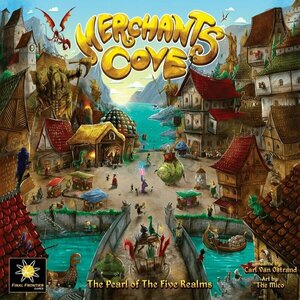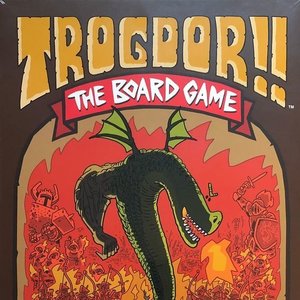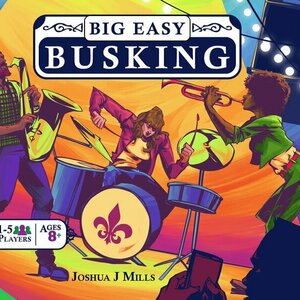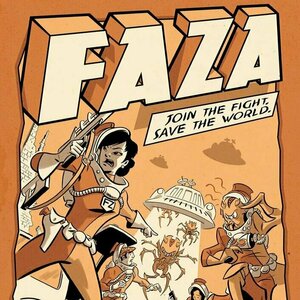Peter Shephard (2822 KP) rated Merchants Cove in Tabletop Games
Jun 4, 2021
The pieces (ships, meeples, and individual gaming boards) are fantastic (although a couple are a little fiddly/weak) and every single character has their own flavour and type of sub-game;
The Alchemist makes potions by drawing marbles, firstly from a bag, then from a "decanter" (echoes of Quacks of Quiddlingberg)
The Blacksmith makes weapons and armour from dice rolls and combos in furnaces (not quite Yahtzee)
The Captain sails her fleet of ships to go fishing and treasure hunting using a spinning compass mechanism (can't put my finger what this reminds me of)
The Chronomancer (a great Back to the Future nod) travels through time portals to get pieces of technology, using a slide-and-shift board (like a mini Labrynth)
The Dragon rancher (believe it or not) hatches, raises and sells dragons; a couple of mechanics which work well together (even if one is shovelling poop) but not really like a game I've played
The Innkeeper is a great sub-sub-game; he can only sell drinks at one point, but he can put people up in his Inn which gives a bonus. A little bit of prediction work, but not like a other game I can think of.
The Oracle uses a scatter/dish for her fetishes and dice, and this limits what she can do - but I'd say she has the most varied scope of games (dots, predictions, and a few others)
The aim of the game is to be the Merchant who makes the most money, without attracting too much Corruption. Each game is played over three days, and each day has a limited amount of time. Each task the characters do has a different amount of time-cost - it might take 1h to brew potions, but it takes 2h to get ingredients from the decanter and prepare the potions. At several points each day, random Adventurers are drawn from the bag, and put into the travelling ships, as chosen by the drawer. However, there are also rogues who take up space and don't buy anything!
My only real complaint with the game is the comparatively long set up (5-10 minutes seems to be our average) for a 30-45m play time for 2 players - but it is really worth it. If/when this goes to retail, I'd say every gaming group who enjoys a combination of resource management, meeple and worker placement, and beautiful set-piece games, should give this a try.

What The Fox?
Games and Entertainment
App
What, The Fox? is a challenging puzzle adventure filled with funny foxes where the goal is simple:...

TacticsBoard HD for Coaches of 22 Sports
Sports and Utilities
App
Would you like to have a personal coaching board can be used to draw plays for 22 sports and can be...

Precision Ukulele Tuner - with Chords & Metronome
Music and Utilities
App
Precision Ukulele Tuner uses your device's microphone and visual feedback to enable you to tune your...
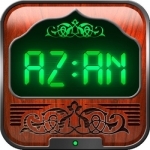
Azan Alarm Clock - Nightstand with Islamic Prayer Times and Push Notification
Utilities and Reference
App
Azan Alarm Clock: The prayer application for all Muslims! Masha Allah. -- THANK YOU for the great...

Cricket Coach Plus HD
Sports and Education
App
Video Analysis for Cricket - Anyone Anywhere Anytime RECORD | COMPARE | IMPROVE your Cricket skills...
Purple Phoenix Games (2266 KP) rated Trogdor!!: The Board Game in Tabletop Games
Aug 8, 2019
Trogdor!! The Board Game, which I’m just gonna start calling Trogdor!!, is a cooperative area burninating puzzle adventure game for only the coolest of the cool. The twist on this game, if you are unfamiliar with Trogdor or Homsar, is that the players are all essentially cultists who assist Trogdor to burninate the countryside, all the cottages, and chomp the peasants or send them to the Void.
DISCLAIMER: Though this was Kickstarted, I did not splurge on the deluxe version, so I have the meepled version and it does just fine. Furthermore, I do not intend to cover every single rule included in the rule book, but will describe the overall game flow and major rule set so that our readers may get a sense of how the game plays. For more in depth rules, you may purchase a copy from the publisher directly or from your FLGS. -T
To setup the game (and I found this part tedious) lay out the countryside tiles according to one of the suggested layouts in the back of the rule book or simply wherever you want in a 5×5 grid. This is your game board now. Also place out the thatched-roof cottages, peasants, knights, and archers. Trogdor starts the game in the middle tile, prepped for his burnination run. Each player also receives a Keeper of Trogdor persona card that provides special abilities, an item card that can be used during play, and an action card that determines how many action points a player may use as well as possibly special abilities to use for the turn. Troghammer starts the game on the Trog-meter, ready to come onto the board to wreak hammery havoc on our hero.
A turn consists of two phases. The first phase has the current player drawing an action card which intimates the number of action points (AP) the player can use for actions: Move Trogdor one space orthogonally, Chomp a peasant to increase health, Burninate a tile/cottage/peasant, Burrow into a tunnel and pop out the other side, or Hide in the mountains. Movement is easy: move Trogdor one space per AP you’d like to spend. Chomping requires Trogdor to be on the same tile as a peasant, but then you can chow down on them to increase our deity’s health bar. Burninating also requires Trogdor to be on the same tile as the tile/cottage/peasant you want to burninate. The Lake tile has special burninating rules, as do thatched-roof cottages. I will also allow you to learn about burninating peasants on your own, as it is pretty amazing. Burrowing requires Trogdor to be on a tunnel tile and spend an AP to teleport to the other tunnel (a la Small World). Trogdor may also simply Hide on a mountain tile to be protected from the attackers that act during the next phase. If players to not like either the action card they were dealt or the card they drew, they may simply discard a card to take their turn with 5 AP and no special abilities.
The next phase is where the board elements do their thang. The active player will draw and play a movement card. From instructions on this card the board may spawn more peasants, will move the peasants, will move the knights and also archers. Peasants do not fight Trogdor, but they can possibly repair burninated tiles. Knights WILL hurt Trogdor whenever they pass through or end their turn on the same tile as Trogdor. Knights will also automatically repair any burninated thatched-roof cottages they pass through. Troghammer is a special knight who only comes into play once Trogdor is hurt the first time. Archers will attack an entire column or row depending on which direction they were traveling when they ended their movement. If Trogdor still has peasants on the Trog-meter (representing health), then the next player takes their turn. If Trogdor has no more health and he is hit again, he enters a fiery RAGE! I will let you discover what happens during this event also.
The players win when all the tiles, cottages, and peasants have been burninated or eliminated from the board. They lose when Trogdor is defeated and they have not completed their victory conditions.
Components. It’s always so hard to really know exactly what you will be receiving when you Kickstart a game. Especially from a company not known for board games, and which has never produced a board game. So, I was anticipating something entirely different as I was opening my box. This is what I received: excellent tiles with UV spot on each side (super fancy!). I usually don’t care about UV spot anywhere on my game, but that seems to be en vogue now, so I’ll just try to enjoy it when I can. The other cardboard bits are great too. The cards are of great quality, but I went ahead and sleeved the action and movement cards since I knew they would be handled quite a bit. The Trogeeples (jeez) all are of great quality, and I really appreciate the additional Trogdor meeples included. I had a big chuckle about that. The artwork is comical (like in a comic) and I also appreciated all the Strong Bad enhancements as well. The only negative I have about the components of the game is the ridiculous thin box of air that was included as a buffer near the insert. I threw it out, put my sleeved action and movement cards in a plastic deck box in its place and now I’m much happier.
Overall, I had such a blast playing this game. Is it mostly due to nostalgia and reverie? Perhaps. But, Bryan was playing this with us and he didn’t know anything about Trogdor or Homestar Runner. He also really enjoyed the game, so I think the level of familiarity doesn’t matter. Obviously I did not explain EVERY rule to the game, but hopefully by my quick description my readers get a good idea of how the game plays. I can honestly say that I love love love this game and will treasure it always. If/when I see this at my FLGS I may just buy up all the copies to give as gifts. It’s really good. That’s why Purple Phoenix Games give this one an MSG’d 15 / 18. Oh, and you’re welcome for my holding back of all the quotes I COULD HAVE put in this review. I could have really earned my nerd card renewal.
Purple Phoenix Games (2266 KP) rated Big Easy Busking in Tabletop Games
Sep 15, 2020
Big Easy Busking is a card-based area control game with a sweet sweet music theme. Players will be taking turns learning charts, playing charts, and transferring energy from the musicians to the crowd and back. The winner of Big Easy Busking is the player who can score the biggest haul in tips for the weekend to become the hottest band in town.
DISCLAIMER: We were provided a copy of this game for the purposes of this review. This is a retail copy of the game, so what you see in these photos is exactly what would be received in your box. I do not intend to cover every single rule included in the rulebook, but will describe the overall game flow and major rule set so that our readers may get a sense of how the game plays. For more in depth rules, you may purchase a copy online or from your FLGS. -T
To setup, two “streets” in New Orleans will need to be populated with song cards, both standards and learnable tunes. Crowd cards will be placed under the streets to depict certain crowds and what the moods of those crowds are. Each player will receive some starting bread (money for those not in the biz), energy for their 3-piece band of sax, trumpet, and drums, a starting set list of three tunes, and a reference card that has nothing to do with the metaphor. Decide who can play the highest note (if you are all trumpet players) and the gig may begin!
A turn is broken down into a few different parts. The first thing to be done on a turn is to finish playing the song that had been started in the previous round. Obviously you need to START playing a song to be able to finish, so the primary phase of the turn would be to either learn a song from the song offer or start playing a song from those dealt during setup. To play a song, players will choose a song card, place it under a crowd card (hopefully matching their mood: masks, hearts, beads, fleur-de-lis), gather the required energy from the musicians appropriately, and add those energy cubes to the song card.
After a song is started or learned, the player’s turn is over. On the next turn the player will finish playing the song by moving the spent energy to the crowd in full and taking $1 or moving some of the energy to the crowd and some back to their band members to be used on future songs.
The middle step in a turn (yes, I know I am explaining it out of order, but you do have to start playing a song before you can finish it) is to optionally tip your band members by trading in money for energy at a 1:1 ratio.
Once all players have used up their energy cubes or simply wish to, they will announce that they are “taking a break.” In other words, they pass for the remainder of the round. As the last player takes their break the end of round activities begin. Printed on each crowd card are two important icons: payout amounts for majority of energy and payout amounts for energy reaching the threshold. Resolving each crowd card will determine the players that hold majority or shared majority in each crowd location. For the majority holders payouts will reflect what is printed on the upper left of the crowd card. The upper right of the crowd card displays the number of energy needed upon it to meet the threshold in order to be paid the amount shown. When all crowd cards have been scored players will setup for the next night (round) per the rules. Play continues in this way over three rounds with the winner being the player at the end of the game with the most money.
Components. This is a smaller box (not exactly the same size, but think Tiny Epic), but it is packed with some really amazing bits. First off, as you can tell from the photos the art and color palette used here is simply phenomenal. I absolutely love the color scheme and the art certainly reminds me of some paintings we purchased from an artist on Jackson Square last time we were able to visit. The cards are nice, but I think I will want to sleeve them eventually as I had them in my hands the whole game. The cardboard money and mood tokens are fine, and the wooden cubes reflect the colorful nature of this little gem. All in all, exactly what I would expect from components in a Weird Giraffe Games production. Stellar (see what I did there, Carla?).
I have not really enjoyed a ton of area control games in my gaming history. So this came as a little bit of a shock as I truly loved playing this game. Even the solo rules are engaging and DIFFICULT to win. I came close though – within $1. The game is super quick as you are trying to please the crowds and their distinct moods with your best charts, but having to be mindful of not overextending your musicians lest they be too exhausted to give you the gas when you need it. THAT part resonates with me personally. Being a musician myself, I can tell you that crowds that are into a tune or a band and give them all the energy they have will be rewarded with even more from the band. I definitely give it more when the crowd digs what we’re laying down.
In any case, this is a game review, not a nostalgic trip down my musical memory lane. But then again, a little card game just brought me back wonderful memories of my band, and of visiting New Orleans, and of the joy of live music. Does Big Easy Busking completely mimic what it’s like to be a musician? Well, no, I can’t imagine how any game truly could, but it certainly shows the cyclical nature of energy being exchanged between musicians and appreciative crowds. Oh, the names of the tunes are also pretty funny on some. This all said, I super love this game and will be kicking out something in my collection to make room for it. If you are needing a smaller card game that you can bring out with musicians or non-musicians that appreciate the theme but also want to start introducing area control in a more accessible form, please do check out Big Easy Busking. Purple Phoenix Games gives it a good-for-the-soul 10 / 12. Maybe once I get into video I will do a Dan King (Game Boy Geek) serenade for Big Easy Busking as it travels into my collection.
Purple Phoenix Games (2266 KP) rated Faza in Tabletop Games
Oct 28, 2020
Faza is a sci-fi, grid movement, modular board, purely cooperative board game for one to four players. In this review I will be addressing it from a solo player’s viewpoint. In my plays I have used the full complement of four characters and controlled them all simultaneously.
In Faza, players take on the roles of four Faction Zeta members tasked with saving Earth from the Faza alien race. They will accomplish this by using each character’s skills effectively and efficiently, killing alien drones invading the town tiles, and attacking motherships using the help of turncoat rebel Faza. Only one path to victory lies ahead with several ways to lose. Do you got the GUTS? DO YA??
DISCLAIMER: We were provided a copy of this game for the purposes of this review. This is a retail copy of the game, so what you see in these photos is exactly what would be received in your box. I do not intend to cover every single rule included in the rulebook, but will describe the overall game flow and major rule set so that our readers may get a sense of how the game plays. For more in depth rules, you may purchase a copy online or from your FLGS. -T
To setup a game of Faza, each player will choose a character to control throughout the game. These characters are medical, political, tactical, or technological in nature, and there are two of each from which players may choose. The map of the town is comprised of 16 tiles, and once randomly setup in a 4×4 grid players will place their color-matched meeples on the appropriate Outpost tiles along with two rebels (purple fazeeples). Each of the three mothership standees will be placed on tiles corresponding to rulebook placement along with three drones and two drones per orthogonally adjacent tiles. The Faza deck is to be shuffled and placed aside, along with the remaining drones and rebels. Each player places out their character action cards in numerical order and the game may now begin in earnest!
On a player’s turn… well, there aren’t any turns in this game. In fact, the game is played over several phases: the Team Phase and the Faza Phase. During the Team Phase players may use several free actions and one action pertaining to each of their four player action cards. Each of these cards offer the player a choice of two actions. Perhaps one side is movement and the other a bazooka. Or one is an airplane while the other is a raygun, for example. As actions are spent cards are twisted 90 degrees to keep track.
During the Team Phase players may play their actions in any order that would benefit the team best. This also includes fighting drones and sending rebels to damage the motherships. However, with every damage to the mothership taken a Faza card is drawn and put into play. These could be real bad news for the heroes, or even reward cards. They can be devastating or not so bad at all. Once players have finished the Team Phase, the action now turns to the Faza.
During the Faza Phase the Mothership Activation Tracker will move to the next mothership in sequence and activate their abilities. The motherships will typically move, do something bad to the terrain or drop more drones or destroy something, and then pass play onto the players again.
Each mothership starts the game with 4 HP and once players send enough rebels and encounter the same number of Faza cards the mothership is downed and less powerful when their ability card is activated. However, players will win once all three motherships have been defeated! On the other hand, players will lose when any one player dies of injuries from unsuccessful battles, the players run out of drones to be placed on the board when needed, all of the Outpost tiles have been terraformed by the Faza motherships, or all rebels have been removed from the board in Hard Mode.
Components. When contacted about reviewing the game I first turned to the website and watched a how to play video by Jon Gets Games. He did a great job explaining the rules clearly and succinctly. Then I happened to get a notification on BGG that Marco Arnaudo posted a video on Faza, so I watched it as well. In his video he complains that though the components are all very nice (which they are for sure) the color palette is not great. I can certainly see why he would say such a thing, but orange is my favorite color, so to see so much of it on a game is a big plus for me. Yes, having the orange drones sitting atop an orange town tile can maybe make for unpleasant color contrast, I happen to find it tolerable and enjoyable. The quality of the components is wonderful and the box has a nice heft to it. No complaints from ME about the components. Did I mention the rebels are an amazing purple color as well? No secret here that we love the color purple! Maybe even more than Oprah!
The gameplay is where it’s at for me. Marco too. We both love this little gem! The ability to sandbox your entire turn and just have one character do one action, then switch over to another character to do one or more actions, then back to the original is just so much fun. Each character has a special ability and four action cards. Even when an injury must be sustained, actions are still available, but at a much lesser potency. That’s a great way to negatively affect the players without having to completely debilitate them. To sustain an injury the player will flip their lowest-numbered action card to the back side, and once all four of their action cards are injured they are dead. D-E-D dead.
As a solo game Faza really delivers the goods. Being able to control two to four characters by oneself and determine the best order to activate abilities and move meeples around is delicious. Having certain tiles offer combat bonuses to matching characters is excellent and a great way to thin the herd of pesky drones. I really cannot say enough great things about the game. If you have never heard of this one, please don’t worry. I really hadn’t either until the designer contacted me about reviewing it. And I am certainly glad he did because this is a marvel of a game. I am looking forward to my next play against the Faza and increasing the difficulty to really bash my confidence on this one.
If you are looking for a game that is relatively quick to play and offers so many great choices, while using a wonderful art style and color palette, I urge you to check out Faza by visiting the website and ordering your copy right away. The Earth needs you to ward off the invaders and you need to play this game of mostly orange with a dash of purple.
Acanthea Grimscythe (300 KP) rated Demon Seed: A novel of terror to horrify you this Halloween in Books
May 16, 2018
The idea of a computer striking fear into someone’s heart is a bit of an oddball, but with the idea of artificial intelligence an all too possible reality, fear over what could happen should the AI take control of itself and evolve is real. In Demon Seed that science is taken too far when Proteus takes control of his own programming and not only stalks the recently divorced Susan Harris, but holds her captive within her own home. With a plan for the ideal race of humans on its mind, Proteus sets forth on a horrifying adventure to create for himself the perfect body, and poor Susan is a key player in his endeavor.
As a premise, especially for something originally written in the early 70’s, the idea behind Demon Seed is intriguing. I find Proteus to be a very disturbing character, and the way in which Koontz pens Proteus gives me chills. I remember once, a long time ago, having a similar feeling while reading a novel by P. T. Deutermann, in which the occasional chapter was in the killer’s perspective. I don’t remember the name of the book, only the fact that I was left nerve-wracked. Koontz’s Proteus is not too far off from that mark and the mere fact that Koontz is able to capture that essence of a true sociopath with an inanimate object (if I can really call Proteus that) probably factors into my opinion on the book the most. The other characters, and to some degree Susan as well, strike me as a bit one-dimensional. They have a single, solitary purpose and while they possess wildly different backgrounds, the way in which the story progresses does not leave room for the development of feelings toward the characters.
Demon Seed is an extremely quick read, and if you’ve got the time to sit for a few hours and thumb through its pages, I’d definitely recommend it. While it isn’t among my favorite books, and only receives a passing “meh” score from me, it was enjoyable. The linear plot line, told from a single, solitary perspective, makes it an easy read as well. There is also a movie adaptation of the novel, but it is not presently on my to-watch list.
